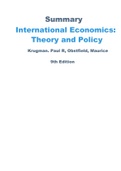Summary
Summary International Economics: Theory and Policy.
- Institution
- Middlesex University (MDX)
Summary International Economics: Theory and Policy. 1. Introduction Throughout the study of international economics seven themes recur: (1) the gafrom trade, (2) the pattern of trade, (3) protectionism, (4) the balance of paymenexchange rate determination, (6) international policy coordination, an...
[Show more]



